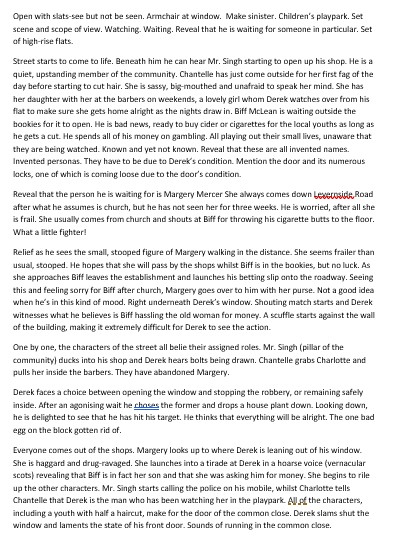So you’ve got an idea for a short story. You’ve pre-planned. You’ve researched extensively (?). Surely the next step is to start writing the thing, no?
You are significantly more likely to abandon your piece if you try to convert what are reasonably dry notes into a juicy narrative – sometimes that gap is just too big to bridge. I try to overcome this by free writing planning. I find this quite a liberating experience; I am writing without rules, without grammar, without the hassle of having to structure or pace or preen. If a lightning piece of dialogue comes into my head, down it goes on the page. If I want to write a detailed description of a nineteenth century blackhouse, I can. This is brainstorming – letting my writer’s mind take me where it wants to go. Consequently, there are some real gems formed in this process. Below is my free planning for Meeting Margery Mercer:

Here is an example of stream-of-consciousness writing. I am telling the story as I would to someone sitting next to me on the bus. Planning in this way takes the trepidation out of starting to write in earnest – the story has already been written once. Although the first opportunity to form a narrative curve, I find planning more useful if I stick to a few simple rules.
- Limit your time writing. This isn’t the time to focus on grammar, syntax etc. This is where your narrative arc is honed. Does the story work? Could I tell it to a friend on the X95 from Edinburgh to Galashiels? If not, it probably is too dense to work as a short story.
- Organise your work into paragraphs. Although seemingly contrary to free writing, this proves useful if I want to move paragraphs around or play with plot later on. It also makes the plan easier to work from when writing your first draft.
- Bear in mind that this is your first opportunity to fuse your research and pre-planning. Strategically placed nuggets of research within your plan will add authenticity to your writing, whilst avoiding research overload (a mistake I have made in the past). Less is more here. The aim is not to prove that you know your subject matter inside-out, but to entertain. If your plan is groaning with the weight of statistics and historical anecdotes, then your full-length draft certainly will be.
Once your scaffolding is complete, congratulations – you have a narrative in front of you! Next is the hard part – writing it properly and writing it better.
For more insight on my writing process, see the following…
Igloos in the Tundra: Idea Formation
A Skeleton to Flesh Out: Pre-planning
Exploration and Sterilisation: Research

Rings true for me! Currently using my phone- on bus, having a coffee, at random points of the day- jotting down situations, narrative, plot points, as I go on a memo file . Working white nicely so far!👌
LikeLiked by 1 person
Definitely the best place for people watching! Research gold dust!
LikeLike
God bless you my man. I needed this.
LikeLiked by 1 person
Just read chapter 1 of your story. Great read – so much anger put across with poise!
LikeLiked by 1 person
Shoot, thank you! Honestly, chapter 2 is better in my opinion, but I appreciate the fact that you peeped my nonsense at all. Thanks again (!!!!)
LikeLiked by 1 person
My pleasure!
LikeLiked by 1 person
I have used this before. Works very well!
LikeLiked by 1 person
Oh, so you do the stream of consciousness thing too. Guess I didn’t invent it!
LikeLiked by 1 person
Oh yes, especially when (at least in my own head) the story is too good to wait. I’m forever forgetting good ideas for stories, so I find that this is the best way of getting it down pronto!
LikeLiked by 1 person